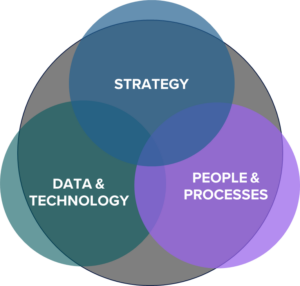Today, every business is flexing its digital muscles and seeking to transform from the traditional way of interacting with customers to the modern, customer-centric approach that requires a strategic internal change. If you want things to change inside your organization, you must rethink how they work. This digital transformation is a momentous effort, especially for large organizations. Some would compare it to pushing an extremely large boulder up a mountain: challenging, but not impossible. What the industry experts will agree upon is that, while each organization’s climb up the transformation mountain will be unique, there are basic principals that can outline a successful path to change.
Digital transformation doesn’t have a set beginning or end point. Technology and customer behaviors are continually evolving. Successful organizations must adopt a culture that can grow and change with the industry. When an organization has a narrow focus on technology, like those that chase the shiny new capability of big tech, it can be a recipe for failure. Buying technology for the sake of having it, in the absence of change management, process, or strategy, will ultimately be a very expensive failure. On the other hand, embarking on a new operating process or hiring for new skill sets without a greater strategy or technology capability present will lead to disruption of corporate culture, and employees will burn out before any momentum can be gained. There is a better way and one that can both empower the organization and gain that sought after alignment at the top.
Marketing Technology News: MarTech Interview with Jason McClelland, CMO at Algolia
We can break digital transformation down into three key pillars defined as:
- Strategy and alignment – The agreed upon future state vision to deliver more integrated experiences and communications
- Data and technology – the information and capabilities needed to attain the future state vision
- People and process – the way of working to drive and deliver the customer-centric experiences
None of these pillars is more important than the other, and for every organization, the roadmap for which each of these is undertaken does not have to be the same. The unifying thread is the balance between these that must be established to succeed. Digital change involves far more than implementing new technologies or reorganizing your reporting structure. Digital transformation is a mindset shift that fundamentally changes how an organization uses technology, people, and processes to improve business performance and deliver on the strategy set forth to actualize the future state vision.
Strategy
Due to the iterative nature of a digital transformation, it is important to first land on a vision and align your organization’s goals. An effective digital transformation strategy should include a framework for you to follow throughout this ever-evolving process. It’s most important to know what you hope to achieve so you can designate KPIs and measure progress along the way.
A well thought-out strategy will also address how the transformation will affect both your customers and your employees. Often when starting this process, the goals of the transformation focuses solely on the customer (understandably, as ultimately this about driving revenue). Realizing what’s best for the customer by understanding their wants and needs is important, but ensuring your strategy includes the internal employee experiences as well will ultimately lead to success.
Data and technology
While, I mentioned above that a good starting point is strategy, one could argue that the best starting point is data. Starting with the customer data you have, the understanding of what customer data will drive revenue, and what KPIs and internal efficiencies you have are all areas that could inform your larger strategy. The balance of these pillars becomes more evident as we walk through them.
This pillar’s focus can inform strategy (using data) and then once the vision is in place, sound technology decisions will need to be made to enable the organizational goals. Your organization should be certain that it’s not just IT making technology decisions in a vacuum, but that all departments are represented to work together on requirements that serve to inform the decision making. The best approach to creating a technology roadmap is to look at the requirements and identify the capabilities needed for both internal and external capabilites to deliver on the strategy. By focusing on the requirements and capabilities, you can make an unbiased call on what technology is the best fit. For example, I have heard organizations say, “We need a customer data platform (CDP)” – this statement is focused on the technology. But why do you need that technology, and what is the capability gap you are looking to fill? The best approach is to say, “We need real-time audience activation.” This statement can easily translate to a requirement, which allows you to accurately look at technology and know up front if it will close your gaps and bring you closer to your future state vision.
People and process
The third pillar is looking to your people and process. Leading change requires a dual focus on digital technology and organizational culture. To succeed, leaders must also consider the intangibles. Some of the hurdles to consider include company culture and department leaders fearful of a specific change. Before determining the roadmap and solution, its best to seek input from all internal partners. Understanding all aspects of the business pain points and providing practical solutions are essential to ensuring all parties feel their needs are understood and for establishing cross-functional support. It is important that the greater organization is involved in decisions from the start and that they feel their concerns are adequately addressed.
Having these conversations with team members about future changes is a top priority before performing any aspect of digital transformation. Explaining to employees how this transformation is going to change the way they work and ensuring that they can continue doing their jobs is critical to increase loyalty and get people excited about the digital transformation plan.
 So, it seems simple enough, right? Well, perhaps not, but be patient. This is an iterative process that does not happen overnight. Think of digital transformation like an evolution. It doesn’t necessarily have a clear end point, but rather it is a continual adaptation to an ever-evolving marketplace. Business leaders who embrace transformation have to consider these three pillars and be willing to innovate, experiment, and communicate with their organizations to make the shift – and in the long run, be agile and flexible in the face of what’s next.
So, it seems simple enough, right? Well, perhaps not, but be patient. This is an iterative process that does not happen overnight. Think of digital transformation like an evolution. It doesn’t necessarily have a clear end point, but rather it is a continual adaptation to an ever-evolving marketplace. Business leaders who embrace transformation have to consider these three pillars and be willing to innovate, experiment, and communicate with their organizations to make the shift – and in the long run, be agile and flexible in the face of what’s next.
Marketing Technology News: MarTech Interview with Rachel Meranus, CMO at Transfix











